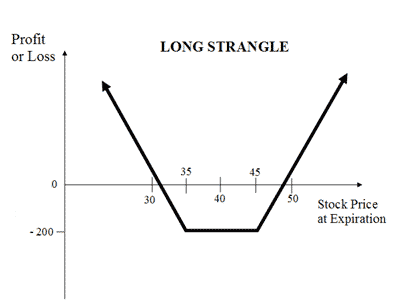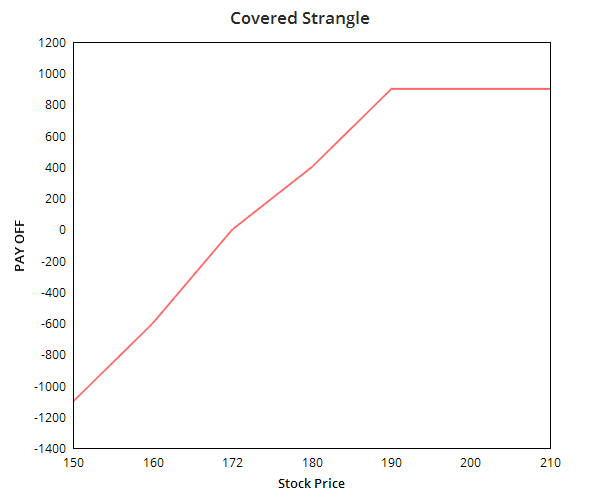 Zerodha (Trading & Demat Account)
Zerodha (Trading & Demat Account)
FREE Equity Delivery and MF
Flat ₹20/trade Intra-day/F&O
 Zerodha (Trading & Demat Account)
Zerodha (Trading & Demat Account)
FREE Equity Delivery and MF
Flat ₹20/trade Intra-day/F&O

|
|
Compare Long Strangle (Buy Strangle) and Covered Strangle options trading strategies. Find similarities and differences between Long Strangle (Buy Strangle) and Covered Strangle strategies. Find the best options trading strategy for your trading needs.
| Long Strangle (Buy Strangle) | Covered Strangle | |
|---|---|---|
 |
 |
|
| About Strategy | The Long Strangle (or Buy Strangle or Option Strangle) is a neutral strategy wherein Slightly OTM Put Options and Slightly OTM Call are bought simultaneously with same underlying asset and expiry date. This strategy can be used when the trader expects that the underlying stock will experience significant volatility in the near term. It is a limited risk and unlimited reward strategy. The maximum loss is the net premium paid while maximum profit is achieved when the underlying moves either significantly upwards or downwards at expiration. The usual Long Strangle Strategy looks like as below for NIFTY current index value at 10400 (NIFTY Spot Price): Options Strangle Orders OrdersNIFTY Strike Price Buy 1 Slightly OTM PutN... Read More | The covered strangle option strategy is a bullish strategy. The strategy is created by owning or buying a stock and selling an OTM Call and OTM Put. It is called covered strangle because the upside risk of the strangle is covered or minimized. The strategy is perfect to use when you are prepared to sell the holding or bought shares at a higher price if the market moves up but would also is ready to buy more shares if the market moves downwards. The profit and in this strategy is unlimited while the risk is only on the downside. |
| Market View | Neutral | Bullish |
| Strategy Level | Beginners | Advance |
| Options Type | Call + Put | Call + Put + Underlying |
| Number of Positions | 2 | 3 |
| Risk Profile | Limited | Limited |
| Reward Profile | Unlimited | Limited |
| Breakeven Point | two break-even points | two break-even points |
| Long Strangle (Buy Strangle) | Covered Strangle | |
|---|---|---|
| When to use? | A Long Strangle is meant for special scenarios where you foresee a lot of volatility in the market due to election results, budget, policy change, annual result announcements etc. |
A covered strangle strategy can be used when you are bullish on the market but also want to cover any downside risk. You are prepared to sell the shares on profit but are also willing to buy more shares in case the prices fall. |
| Market View | Neutral When you are unsure of the direction of the underlying but expecting high volatility in it. |
Bullish The Strategy is perfect to apply when you're bullish on the market and expecting less volatility in the market. |
| Action |
Suppose Nifty is currently at 10400 and you expect the price to move sharply but are unsure about the direction. In such a scenario, you can execute long strangle strategy by buying Nifty at 10600 and at 10800. The net premium paid will be your maximum loss while the profit will depend on how high or low the index moves. |
Buy 100 shares + Sell OTM Call +Sell OTM Put The covered strangle options strategy can be executed by buying 100 shares of a stock while simultaneously selling an OTM Put and Call of the same the stock and similar expiration date. |
| Breakeven Point | two break-even points A Options Strangle strategy has two break-even points. Lower Breakeven Point = Strike Price of Put - Net Premium Upper Breakeven Point = Strike Price of Call + Net Premium |
two break-even points There are 2 break-even points in the covered strangle strategy. One is the Upper break even point which is the sum of strike price of the Call option and premium received while the other is the lower break-even point which is the difference strike price of short Put and premium received. |
| Long Strangle (Buy Strangle) | Covered Strangle | |
|---|---|---|
| Risks | Limited Max Loss = Net Premium Paid The maximum loss is limited to the net premium paid in the long strangle strategy. It occurs when the price of the underlying is trading between the strike price of Options. |
Limited The risk on this strategy is only on the downside when the price moves below the strike price of the Put option. |
| Rewards | Unlimited Maximum profit is achieved when the underlying moves significantly up and down at expiration. Profit = Price of Underlying - Strike Price of Long Call - Net Premium Paid Or Profit = Strike Price of Long Put - Price of Underlying - Net Premium Paid |
Limited The maximum profit on this strategy happens when the stock price is above the call price on expiry. The profit is the total of the gain from buying/selling stocks and net premium received on selling options. |
| Maximum Profit Scenario | One Option exercised |
You will earn the maximum profit when the price of the stock is above the Call option strike price on expiry. You will be assigned on the Call option, would be able to sell holding shares on profit while retaining the premiums received while selling the options. |
| Maximum Loss Scenario | Both Option not exercised |
The maximum loss would be when the stock price falls drastically and turns worthless. The premiums received while selling the options will compensate for some of the loss. |
| Long Strangle (Buy Strangle) | Covered Strangle | |
|---|---|---|
| Advantages |
|
|
| Disadvantage | The strategy requires significant price movements in the underlying to gain profits. |
|
| Simillar Strategies | Long Straddle, Short Strangle | Long Strangle, Short Strangle |

Add a public comment...

FREE Intraday Trading (Eq, F&O)
Flat ₹20 Per Trade in F&O
|
|